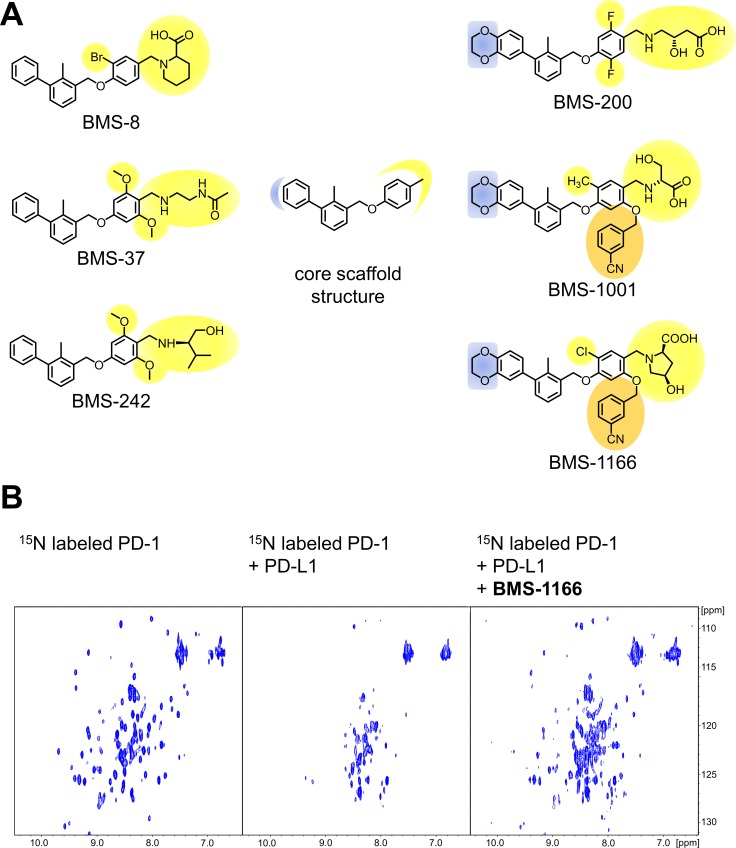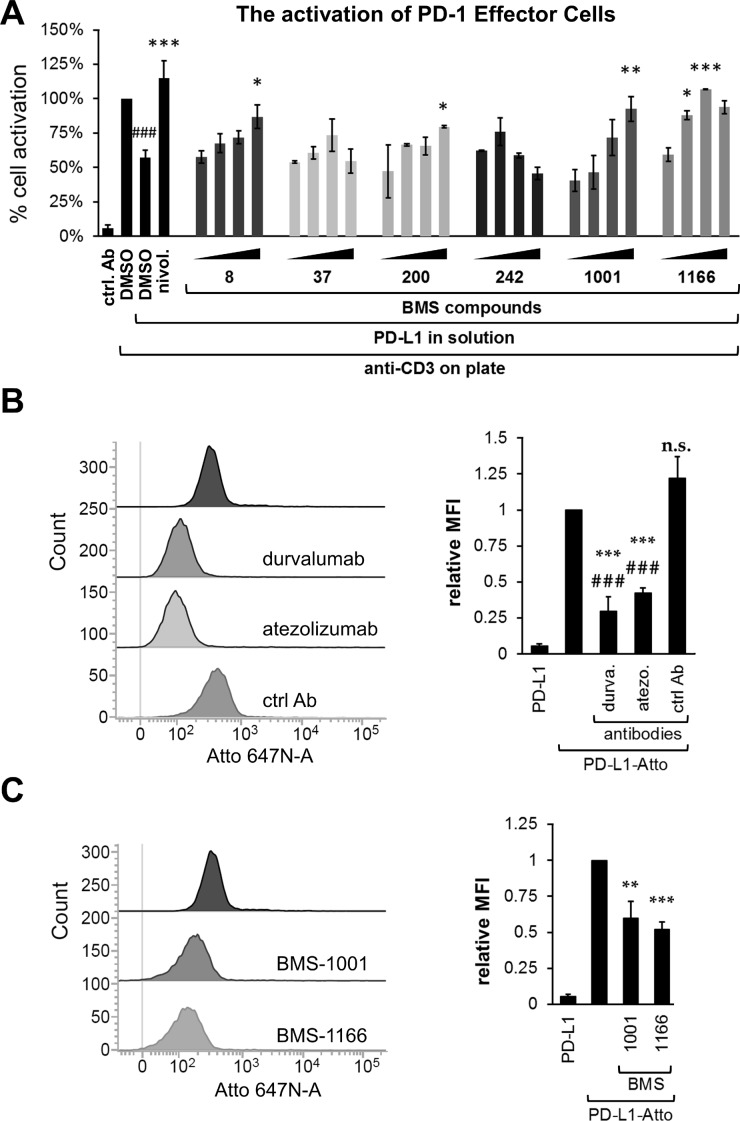
| Size | Price | |
|---|---|---|
| 500mg | ||
| 1g | ||
| Other Sizes |
Purity: ≥98%
BMS-200 is a novel and potent small molecule inhibitor of the PD-1/PD-L1 protein protein interaction with IC50 value of 80 nM in cell free assays. Bristol-Myers Squibb was the first to find it. Monoclonal antibodies have significantly improved cancer treatment by blocking the PD-1/PD-L1 immune checkpoint pathway. A number of drawbacks to antibody-based immunotherapies exist, including the high cost of the antibodies, their short half-life, and their immunogenicity. Due to the lack of complete structural knowledge for this pathway, the development of small-molecule PD-1/PD-L1 inhibitors that could overcome these limitations is slow. Bristol-Myers Squibb recently revealed BMS-1001 and its analogs as the first chemical PD-1/PD-L1 inhibitors.
| ln Vitro |
BMS-1001, a novel and potent small molecule inhibitor, has an IC50 value of 2.25 nM in cell-free assays for the PD-1/PD-L1 protein protein interaction.
|
||
|---|---|---|---|
| ln Vivo |
|
||
| Enzyme Assay |
BMS recently revealed the first nonpeptidic small molecule inhibitors for the PD-1/PD-L1 pathway that demonstrated activity in a homogeneous time-resolved fluorescence (HTRF) binding assay, but no additional evidence was provided to support their activity.
|
||
| Animal Protocol |
|
||
| References |
| Molecular Formula |
C27H27F2NO6
|
|
|---|---|---|
| Molecular Weight |
499.503195047379
|
|
| Exact Mass |
499.18
|
|
| Elemental Analysis |
C, 64.92; H, 5.45; F, 7.61; N, 2.80; O, 19.22
|
|
| CAS # |
1675203-82-3
|
|
| Related CAS # |
|
|
| PubChem CID |
117941887
|
|
| Appearance |
Solid powder
|
|
| LogP |
1.3
|
|
| Hydrogen Bond Donor Count |
3
|
|
| Hydrogen Bond Acceptor Count |
9
|
|
| Rotatable Bond Count |
10
|
|
| Heavy Atom Count |
36
|
|
| Complexity |
701
|
|
| Defined Atom Stereocenter Count |
1
|
|
| SMILES |
CC1=C(C=CC=C1C2=CC3=C(C=C2)OCCO3)COC4=C(C=C(C(=C4)F)CNC[C@H](CC(=O)O)O)F
|
|
| InChi Key |
UUBRFEROHJGRBO-FQEVSTJZSA-N
|
|
| InChi Code |
InChI=1S/C27H27F2NO6/c1-16-18(3-2-4-21(16)17-5-6-24-26(10-17)35-8-7-34-24)15-36-25-12-22(28)19(9-23(25)29)13-30-14-20(31)11-27(32)33/h2-6,9-10,12,20,30-31H,7-8,11,13-15H2,1H3,(H,32,33)/t20-/m0/s1
|
|
| Chemical Name |
(3S)-4-[[4-[[3-(2,3-dihydro-1,4-benzodioxin-6-yl)-2-methylphenyl]methoxy]-2,5-difluorophenyl]methylamino]-3-hydroxybutanoic acid
|
|
| Synonyms |
|
|
| HS Tariff Code |
2934.99.9001
|
|
| Storage |
Powder -20°C 3 years 4°C 2 years In solvent -80°C 6 months -20°C 1 month |
|
| Shipping Condition |
Room temperature (This product is stable at ambient temperature for a few days during ordinary shipping and time spent in Customs)
|
| Solubility (In Vitro) |
|
|||
|---|---|---|---|---|
| Solubility (In Vivo) |
Note: Listed below are some common formulations that may be used to formulate products with low water solubility (e.g. < 1 mg/mL), you may test these formulations using a minute amount of products to avoid loss of samples.
Injection Formulations
Injection Formulation 1: DMSO : Tween 80: Saline = 10 : 5 : 85 (i.e. 100 μL DMSO stock solution → 50 μL Tween 80 → 850 μL Saline)(e.g. IP/IV/IM/SC) *Preparation of saline: Dissolve 0.9 g of sodium chloride in 100 mL ddH ₂ O to obtain a clear solution. Injection Formulation 2: DMSO : PEG300 :Tween 80 : Saline = 10 : 40 : 5 : 45 (i.e. 100 μL DMSO → 400 μLPEG300 → 50 μL Tween 80 → 450 μL Saline) Injection Formulation 3: DMSO : Corn oil = 10 : 90 (i.e. 100 μL DMSO → 900 μL Corn oil) Example: Take the Injection Formulation 3 (DMSO : Corn oil = 10 : 90) as an example, if 1 mL of 2.5 mg/mL working solution is to be prepared, you can take 100 μL 25 mg/mL DMSO stock solution and add to 900 μL corn oil, mix well to obtain a clear or suspension solution (2.5 mg/mL, ready for use in animals). View More
Injection Formulation 4: DMSO : 20% SBE-β-CD in saline = 10 : 90 [i.e. 100 μL DMSO → 900 μL (20% SBE-β-CD in saline)] Oral Formulations
Oral Formulation 1: Suspend in 0.5% CMC Na (carboxymethylcellulose sodium) Oral Formulation 2: Suspend in 0.5% Carboxymethyl cellulose Example: Take the Oral Formulation 1 (Suspend in 0.5% CMC Na) as an example, if 100 mL of 2.5 mg/mL working solution is to be prepared, you can first prepare 0.5% CMC Na solution by measuring 0.5 g CMC Na and dissolve it in 100 mL ddH2O to obtain a clear solution; then add 250 mg of the product to 100 mL 0.5% CMC Na solution, to make the suspension solution (2.5 mg/mL, ready for use in animals). View More
Oral Formulation 3: Dissolved in PEG400 (Please use freshly prepared in vivo formulations for optimal results.) |
| Preparing Stock Solutions | 1 mg | 5 mg | 10 mg | |
| 1 mM | 2.0020 mL | 10.0100 mL | 20.0200 mL | |
| 5 mM | 0.4004 mL | 2.0020 mL | 4.0040 mL | |
| 10 mM | 0.2002 mL | 1.0010 mL | 2.0020 mL |
*Note: Please select an appropriate solvent for the preparation of stock solution based on your experiment needs. For most products, DMSO can be used for preparing stock solutions (e.g. 5 mM, 10 mM, or 20 mM concentration); some products with high aqueous solubility may be dissolved in water directly. Solubility information is available at the above Solubility Data section. Once the stock solution is prepared, aliquot it to routine usage volumes and store at -20°C or -80°C. Avoid repeated freeze and thaw cycles.
Calculation results
Working concentration: mg/mL;
Method for preparing DMSO stock solution: mg drug pre-dissolved in μL DMSO (stock solution concentration mg/mL). Please contact us first if the concentration exceeds the DMSO solubility of the batch of drug.
Method for preparing in vivo formulation::Take μL DMSO stock solution, next add μL PEG300, mix and clarify, next addμL Tween 80, mix and clarify, next add μL ddH2O,mix and clarify.
(1) Please be sure that the solution is clear before the addition of next solvent. Dissolution methods like vortex, ultrasound or warming and heat may be used to aid dissolving.
(2) Be sure to add the solvent(s) in order.
 Structures and the PD-1/PD-L1 blocking potential of BMS compounds.Oncotarget.2017Aug 7;8(42):72167-72181. |
|---|
Cytotoxicity and activity of BMS compounds in PD-1/PD-L1 checkpoint assay.Oncotarget.2017Aug 7;8(42):72167-72181. |
 BMS compounds restore the sPD-L1-supressed activation of Jurkat T-cells.Oncotarget.2017 |
BMS-1166 induces binding cleft opening.Oncotarget.2017Aug 7;8(42):72167-72181. |
|---|
Decomposition of BMS-1166.Oncotarget.2017Aug 7;8(42):72167-72181. |
 he prediction of BMS-1001 and −1166 binding sites on PD-L1 surface.Oncotarget.2017Aug 7;8(42):72167-72181. |